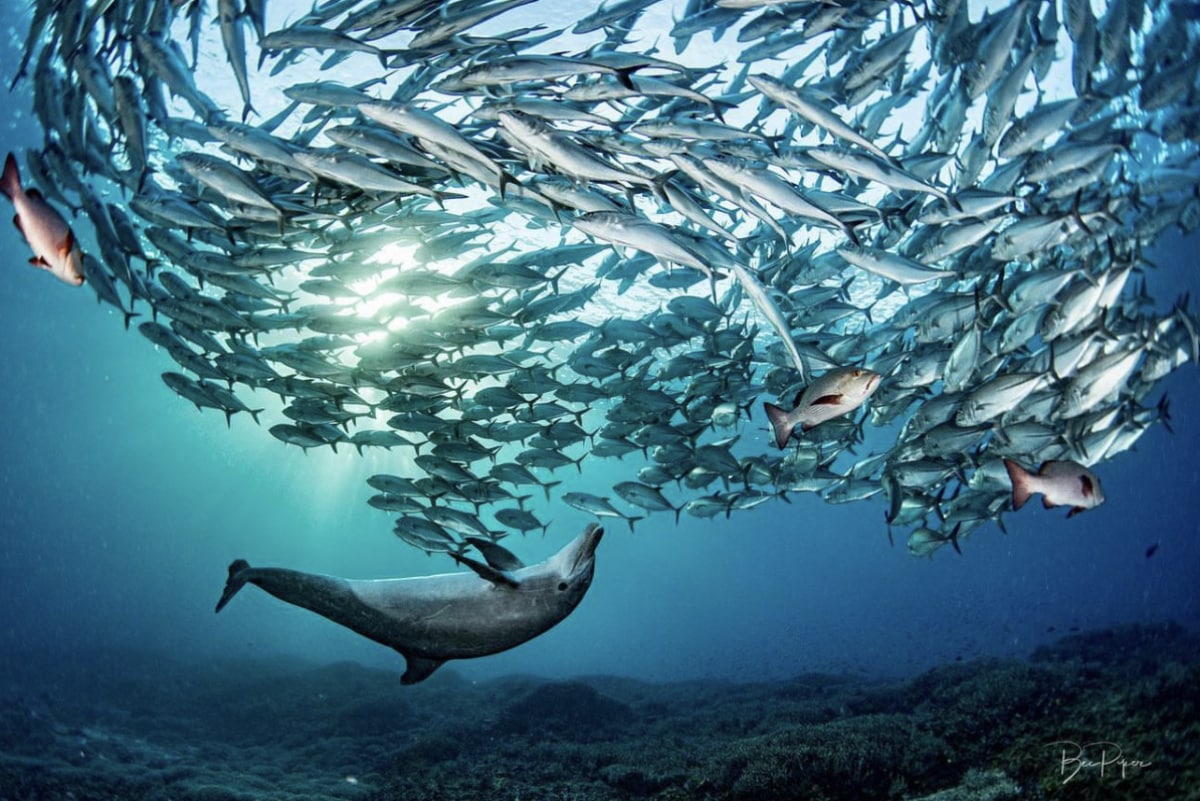Lady Elliot Island Eco Resort is thrilled to announce a new Bottlenose Dolphin calf has been born to one of our local pods! You have likely heard of “Bubbles” (also known as Notchy), well his little pod includes a female dolphin named “Sammy” and until recently, their calf named “Squiggles” who has now reached maturity and moved off to associate with other dolphins!

Pictured: Sammy with her new calf, Splash!
Image credit: @finsandphotography
PhD candidate Georgina Hume is currently studying local dolphin pods in the Hervey Bay region and provided us with some insight into their distribution and family ties.
“Here on the east coast of Australia, we have 2 species of bottlenose, our larger common bottlenose dolphins that tend to be darker in colouration and the Indo-Pacific bottlenose dolphins. Sometimes we find these two species in mixed species groups in the area, and particularly around the more coastal waters of QLD.”
Where did the name Splash come from?
During a visit to Bundaberg to celebrate 20 years of the reef guardian school program, a local school student suggested the name!
How long does the calf stay with the parents and what is the social structure of their pods?
A bottlenose dolphin calf will generally remain with its mother for between three to six years. Our recent calf appeared to stay with its mother for at least four years.
“Bottlenose dolphins are known to form alliances. You’ll often find male alliance groups hanging out together, and then female groups often comprising of related individuals too. They can be found in larger ‘super-groups’ of hundreds of individuals, but here we often find them in smaller groups of 3-20 individuals”.
“It’s currently unknown what the home ranges of our local bottlenose along the east coast are, and how much these individuals travel between populations.”



Image credit: @conor_dives
What is the average lifespan of this species?
Bottlenose dolphins have been recorded living up to 60 years of age.
What does their diet consist of?
Their diet mainly consists of squid, fish and crustaceans which may be caught by an individual or through group hunting methods. Here on Lady Elliot, we frequently see local dolphins chasing a school of big eye trevally and eating their regurgitated food!


Image credit: @bec.piper.photography
What makes Dolphins so smart?
Well, firstly – they have big brains! Their brain to body mass ratio is very high, second only to humans. They possess complex communication skills and have passed the mirror test – suggesting that they are self-aware animals! They are also capable of complex problem solving and social interaction, utilising their brain power to work together as groups when feeding!
How can I maximise my chances of seeing dolphins while visiting the island?
It’s important to remember that these are wild animals and their behaviour and whereabouts can be difficult to predict! Over the years, it does seem that dolphins come into the reef more frequently in the early mornings and are sighted until around midday. They appear to search for the ball of big-eye trevally that lives on the reef as they chase these fish, force them to vomit and then consume their vomit!
Our recommendation is an early morning snorkel between second reef and coral gardens, or you could join a snorkel safari or glass bottom boat tour where we also sight dolphins on occasion. If you do encounter them, remember to give plenty of space while they carry out their natural behaviours. Please remember: If approached by a whale or dolphin, a swimmer must move slowly to avoid startling the animal and must not attempt to touch it or swim towards it (Australian National Guidelines for Whale and Dolphin Watching).

Pictured: Where Bubbles got his name from!
Image Credit: Bruce Hammond

 Snorkel & Dive
Snorkel & Dive Sustainability
Sustainability